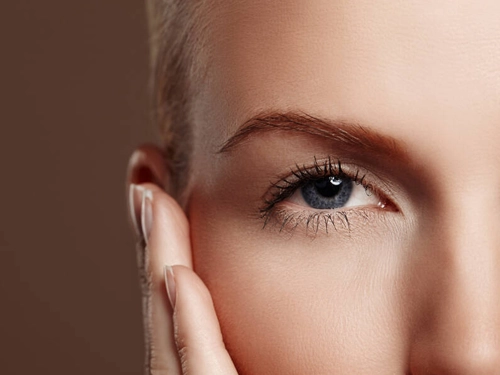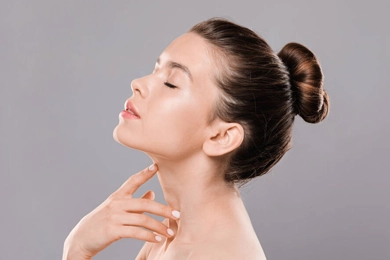
Upper eyelid drooping or sagging that makes you appear tired or older than your years? Blepharoplasty of the upper eyelids may be the solution you've been seeking.
By removing excess skin and fat from the upper eyelids, this surgical procedure helps restore a youthful appearance. This guide covers everything you need to know about upper eyelid blepharoplasty, from the procedure and its benefits to recovery and what to expect.
Upper eyelid blepharoplasty, also known as upper eyelid surgery, is a cosmetic procedure designed to restore the upper eyelids youthful appearance. The surgery removes excess skin, muscle, and fat that contribute to a sagging or drooping appearance. The result is a rejuvenated, more youthful appearance that can boost your confidence and, if the excess skin was obstructing your vision, improve your vision.
Closing the Incisions -The incisions are meticulously closed with fine sutures to ensure minimal scarring.
Recovery from upper eyelid blepharoplasty typically takes between one and two weeks. It is essential to adhere to your surgeon's aftercare instructions for optimal results. Some common recommendations include:
Blepharoplasty of the upper eyelids is an effective treatment for those seeking a more youthful, revitalized appearance or improved vision due to drooping upper eyelids. By understanding the procedure, its benefits, and the recovery process, one can make informed decisions.
It is essential to consult a board-certified plastic surgeon who specializes in facial procedures if you are considering upper eyelid blepharoplasty. They will be able to assess your unique needs, discuss your objectives, and develop a specialized treatment plan to help you achieve the best possible results.
Please contact us if you have any questions about upper eyelid blepharoplasty or would like to schedule a consultation with our expert team. We are here to assist you in achieving a revitalized, more youthful appearance.
Keep in mind that the success of your upper eyelid blepharoplasty will depend heavily on the skill and experience of your plastic surgeon. Research and select a surgeon with a proven track record in facial procedures and a dedication to patient satisfaction. Your eyes are a crucial aspect of your appearance, and you deserve the best care and results possible.
A common cosmetic procedure called upper eyelid blepharoplasty can significantly improve the appearance of droopy or sagging upper eyelids, giving the face a more youthful and rested appearance. You probably have some inquiries about the procedure, the healing period, and the anticipated results if you're thinking about having this surgery. In order to give you a thorough understanding of the procedure, we'll address 50 frequently asked questions about upper eyelid blepharoplasty.
Upper eyelid blepharoplasty is a surgical procedure that slims the upper eyelids by removing extra skin, fat, and occasionally muscle. The result is a more youthful and revitalized appearance.
The procedure can make sagging or droopy upper eyelids look better, lessen the appearance of fatigue, and give the face a more awake and youthful appearance.
Ideal candidates have realistic expectations, are in good general health, and have extra skin or fat in their upper eyelids that give them a tired or old look.
Usually, the procedure is carried out while the patient is sedated or under general anesthesia. The surgeon makes an incision in the upper eyelid's natural crease, trims away any extra skin, fat, and occasionally muscle, and then sews the wound shut with sutures or surgical glue.
Depending on the degree of the required correction, upper eyelid blepharoplasty typically takes 1-2 hours to complete.
Yes, it is typical for patients to have both upper and lower eyelid surgery (blepharoplasty) done at the same time in order to produce a more symmetrical and pleasing outcome.
For the first few days after surgery, there is frequently some swelling, bruising, and discomfort. Within 7 to 10 days, patients can usually resume their regular activities and go back to work.
Upper eyelid blepharoplasty typically produces long-lasting results, with many patients experiencing positive outcomes for 10 years or longer. The surgery does not, however, stop the aging process naturally, and some patients may eventually need a revision procedure.
There are potential risks and side effects with any surgery, including infection, bleeding, scarring, dry eyes, transient or long-term changes in vision, and asymmetry. However, when the procedure is carried out by a skilled, board-certified plastic surgeon, these risks are comparatively infrequent.
Upper eyelid blepharoplasty prices vary depending on the experience of the surgeon, the difficulty of the procedure, and the facility's location. The procedure typically costs between $2,000 and $5,000.
If the procedure is deemed medically necessary, such as when the sagging of the upper eyelids impairs vision, insurance may cover the cost of the procedure. However, insurance frequently won't pay for procedures that are only for cosmetic reasons.
Choose a board-certified plastic surgeon with upper eyelid blepharoplasty experience. Choose a surgeon who has a solid track record, glowing patient reviews, and before-and-after pictures that show their skill.
Yes, for a more thorough facial rejuvenation, upper eyelid blepharoplasty can be combined with other facial procedures like lower eyelid blepharoplasty, facelift, brow lift, or Botox injections.
Scars are typically well concealed within the upper eyelid's natural crease, making them less noticeable after healing.
Within 7–10 days, swelling and bruising typically start to go away, though some residual swelling may last for weeks.
The majority of patients can start wearing makeup again 7 to 10 days after surgery, but it's crucial to adhere to your surgeon's specific instructions.
After an upper eyelid blepharoplasty, it is generally advised to avoid heavy lifting and strenuous exercise for at least 2-4 weeks. For specific guidance on starting a fitness routine again, speak with your surgeon.
For at least one to two weeks following surgery, or until your surgeon gives you the all-clear, you should refrain from wearing contact lenses.
Depending on the nature of their job and the extent of the procedure, the majority of patients can return to work 7 to 10 days after the operation.
While some improvement might be seen within a few weeks, upper eyelid blepharoplasty final results typically show up after 3-6 months as swelling continues to go down.
Using an upper eyelid blepharoplasty, mild to moderate eye asymmetry can be corrected. Perfect symmetry, however, might not always be possible.
Incisions are made with a scalpel during traditional upper eyelid blepharoplasty while they are made with a laser during laser-assisted procedures. Less bleeding and swelling may be experienced with laser-assisted blepharoplasty, but the best technique will depend on the needs of each patient and the surgeon's skill.
By removing extra skin and fat from the upper eyelids, blepharoplasty can subtly change the shape of the eyes, giving them a more open, alert appearance.
Your surgeon will give you detailed pre-operative instructions, which may include stopping taking specific medications, abstaining from alcohol and smoking, and making arrangements for someone to help you during the first few days after surgery.
Care for your incisions according to your surgeon's specific instructions, which may include using a cotton swab to gently clean the incision sites and applying an antibiotic ointment.
Within 24-48 hours following surgery, you might be able to take a shower, but avoid getting water on your face and surgical incisions. Observe the instructions for bathing and showering provided by your surgeon.
Yes, by removing extra skin and fat from the upper eyelids, upper eyelid blepharoplasty can effectively treat hooded eyes, giving the eyes a more open and youthful appearance.
An incision is made on the inner surface of the upper eyelid rather than in the crease when performing a transconjunctival upper eyelid blepharoplasty. This method is less popular and is typically used on patients who need to remove fat but have little extra skin.
Your plastic surgeon will assess your facial features, go over your goals, and decide whether you are a good candidate for upper eyelid blepharoplasty during your initial consultation. Additionally, they will describe the process, any dangers, and the anticipated results.
To manage discomfort following surgery, your doctor may prescribe painkillers. Cold compresses, elevating your head, and over-the-counter painkillers can all help reduce pain and swelling.
Upper eyelid blepharoplasty is most often used to treat upper eyelid problems. Lower eyelid blepharoplasty or other procedures might be suggested to treat under-eye bags.
While non-surgical methods like Botox, filler injections, or laser resurfacing are available to treat minor signs of aging around the eyes, they cannot correct the condition to the same degree as upper eyelid blepharoplasty.
Avoiding foods or supplements like alcohol, aspirin, or vitamin E that can slow the healing process or increase the risk of bleeding may be advised by your surgeon.
Crow's feet are not specifically addressed by upper eyelid blepharoplasty, which primarily concentrates on the upper eyelids. Your surgeon might suggest additional procedures, like Botox or laser resurfacing, to treat crow's feet.
Patients with various skin types can have upper eyelid blepharoplasty procedures done on them. The risk of complications may be higher for people with certain medical conditions or for those with very thin or dry skin.
Your plastic surgeon will talk to you about your expectations for the procedure during your consultation. They will assist you in forming reasonable expectations and in understanding what the procedure can accomplish.
Ptosis of the upper eyelids can be treated with blepharoplasty. However, a different procedure known as ptosis repair may be necessary if the ptosis is more severe or was brought on by muscle weakness.
Practice good skincare practices, shield your skin from sun damage, and lead a healthy lifestyle to maintain your results. Additionally, non-surgical procedures like Botox or fillers can help extend the results.
Although there is no set age limit for upper eyelid blepharoplasty, patients in their 40s and older are most frequently the ones who undergo the procedure. But younger patients who have a genetic propensity for drooping upper eyelids might also be candidates.
Depending on the patient's preferences and the surgeon's recommendation, upper eyelid blepharoplasty can be carried out under local anaesthesia with sedation or general anaesthesia.
Sutures are typically taken out 5-7 days after surgery, but the precise time will depend on your surgeon's preference and how quickly you heal.
Under-eye bags cannot be treated with an upper eyelid blepharoplasty. This problem might be better addressed with procedures like lower eyelid blepharoplasty, dermal fillers, or laser resurfacing.
After surgery, you can usually wear glasses, but you might need to wait a few days for the swelling to go down. Make sure to heed the specific advice given by your surgeon.
Flying should generally be avoided for at least 7 to 10 days following surgery, but speak with your doctor for specific recommendations.
After surgery, patients might feel a little sore, swollen, or bruised, but pain is typically well-managed with prescribed pain medication and at-home care.
Upper eyelid blepharoplasty may be able to improve vision if sagging upper eyelids are obstructing it by removing extra skin and fat.
After an upper eyelid blepharoplasty, you can certainly get chemical peels or laser resurfacing, but you should hold off until your surgeon gives the all-clear, usually after 3-6 months.
Non-surgical procedures like Botox, dermal fillers, and laser resurfacing are alternatives to upper eyelid blepharoplasty, but they typically provide less dramatic and long-lasting results.
For the first few days following surgery, sleep with your head elevated on several pillows to help with healing and reduce swelling.
Upper eyelid blepharoplasty may still be an option for patients with dry eyes, but it's important to discuss your unique circumstances with your surgeon. In order to reduce the possibility of complications, they might suggest additional therapies or safety measures.
 Liquid Facelift
Liquid FaceliftAre you looking for a non-surgical facelifting procedure to replace your current procedure? You might be a candidate for the liquid facelift. Read More...